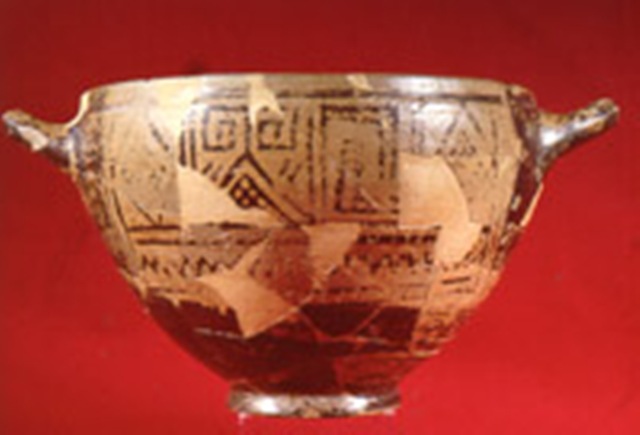The Cup of Nestor is an “orientalized” clay drinking cup, also known as a kotyle. It dates to the Geometric Period, around 750-700 B.C. It was found on the island of Ischia in Italy, the region known as Magna Graecia. During ancient times, the site was called Pithekoussai, incidentally one of the earliest Greek colonies located in the West.
Nestor’ Cup is the first example of epigraphic (inscriptional) writing. This is the first piece found that uses the Phoenician-influenced Greek alphabet for the very first time. It is believed that since it corresponds closely to the Euboean sphere of trading interests, the region of Euboea first adapted the alphabet.
The text on the cup is written in hexameters. It appears to make an illusion to Homeric poetry, particularly the Illiad (11.632-637) where a cup belonging to Nestor, the king of Pylos, is described. It is believed to be a joke about love or even potentially sex, connected to the idea of drinking.
Although it is not very clear because of missing shards, the inscription reads:
ΝΕΣΤΟΡΟΣ:...:ΕΥΠΟΤΟΝ:ΠΟΤΕΡΙΟΝ ΗΟΣΔΑΤΟΔΕΠΙΕΣΙ:ΠΟΤΕΡΙ..:ΗΥΤΙΚΑΚΕΝΟΝ ΗΙΜΕΡΟΣΗΑΙΡΕΣΕΙ:ΚΑΛΛΙΣΤΕΦΑΝΟ:ΑΦΡΟΔΙΤΕΣ
Uniquely, it is written from right to left in three lines. Translated, it reads:
I am Nestor’s cup, good to drink from. Whoever drinks this cup empty, straightaway Desire for beautiful-crowned Aphrodite will seize him.
There have been many interpretations of such text. It clearly states the possible owner of the cup in the first line, but the next two following lines are not so direct. The second line appears to hint at possible inebriation. The last line is the most intriguing for it mentions the Greek goddess of love and beauty. Indeed, one could potentially interpret the text as saying that if one drinks the cup and becomes intoxicated, one will fall in love, possibly with the goddess herself, or rather, one will become lustful, possibly for the goddess herself. I tend to agree with the latter more than the former interpretation.
Nestor’s Cup is presently in the Villa Arbusto Museum in the village of Lacco Amerno, in Ischia.

Whitley, James. The Archaeology of Ancient Greece. (New York, 2007). 100, 130-3, 209.
Posted at Dec 16/2007 10:24PM:
Kuy Yeon Lee: Nice work!! helped me a lot with the final since we knew that this would come up for slide IDs...
